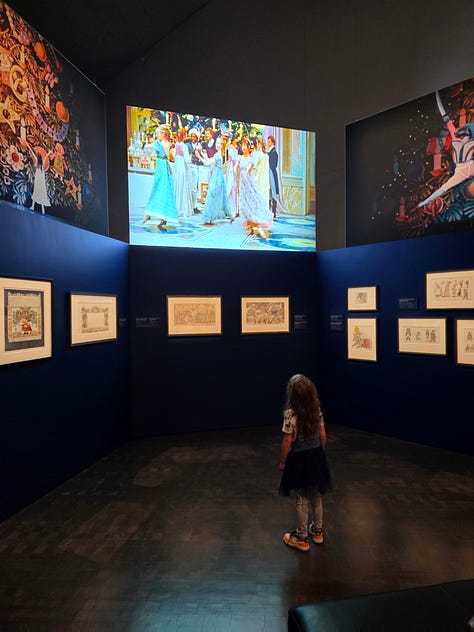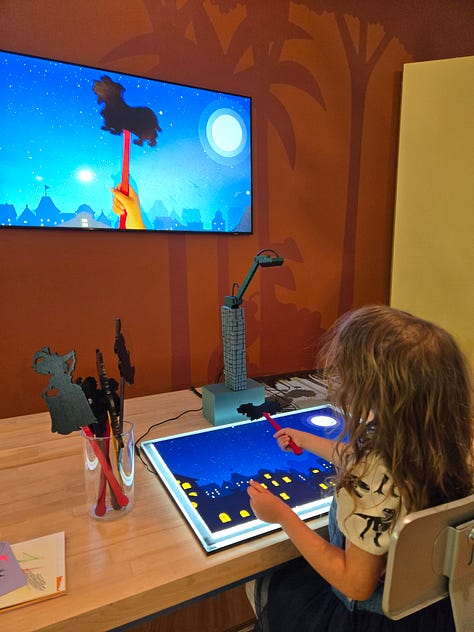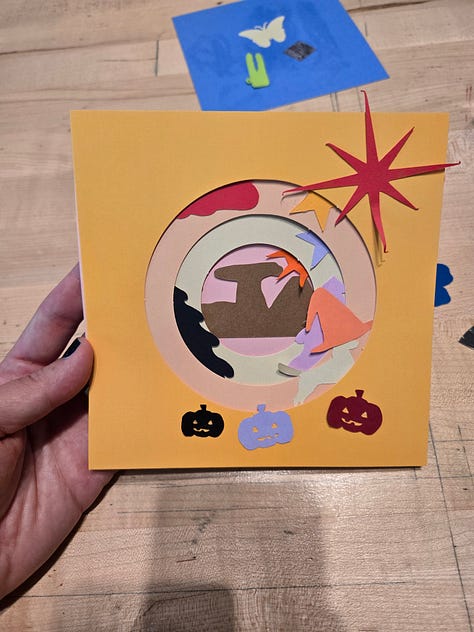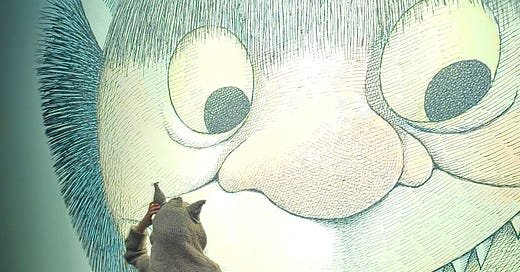Back when I was doing my Master’s and working on research related to children’s literature, I read a fair amount about Maurice Sendak and how he depicts childhood through liminal spaces. As a child, I obviously enjoyed his 1963 book Where the Wild Things Are, but my favorite of his was always Higglety Pigglety Pop! or There Must Be More to Life, which, for some reason, is so dear to me that I still have it stashed away with my treasures. It turns out that was his favorite of his books too, a tribute to his dog Jennie when she was diagnosed with cancer. Three images from the book were the only art of his own that he hung in his home.
When I read scholarship about Sendak’s work, I was often struck by how childlike he seemed in sometimes odd ways.
For example, he recounts one of his favorite letters:
“I sent him a postcard and I drew a picture of a Wild Thing on it. I wrote, 'Dear Jim, I loved your card.' Then I got a letter back from his mother and she said, 'Jim loved your card so much he ate it.' That to me was one of the highest compliments I’ve ever received. He didn’t care that it was an original drawing or anything. He saw it, he loved it, he ate it." (Upworthy)
He’s just so charmingly, authentically, weird. Wild.
Now, my daughter also enjoys Where the Wild Things Are, but her favorite art by Sendak are his illustrations for the Little Bear series of books which we read and reread regularly.
For her fall break, we were excited to see Wild Things: The Art of Maurice Sendak at the Denver Art Museum.
We even had outfits for the occasion. In 2009, I knit matching sweaters for my little sibling, MJ, and me, using the pattern Wild Thing by Homero Luna. The design was created to coincide with the Dave Eggars book and film adaptation that came out that year. Now that MJ is grown, I have both sweaters, but I knitted up a new tail to replace the original, which had gone missing over the years. (I happened to have some fun fur leftover from knitting a Daniel Striped Tiger puppet.)
Wild Things includes more than 400 works by Maurice Sendak from across his 65-year career as an artist, illustrator, and set designer, as well as artists who inspired him such as Wiliam Blake, Beatrix Potter, and Walt Disney, and collaborators such as Caorle King, Spike Jonze, and Tony Kushner.
Both Sendak’s critics and his fans point to how he dwells on the scary aspects of childhood and how little control kids have over them. He hoped to help kids make it through those scary moments with his work. The gallery draws out this contrast between the whimsical and the monstrous in Sendak’s art while also exploring his connection to his Jewish culture and Brooklyn neighborhood. It really creates a vivid portrait of Sendak and it was fun to explore both the art and the creative elements of the gallery setup itself.
Some of the highlights for me:
The audio guide was available in two versions—one for adults and one for kids. Although the adult version had more info, the production of the kids’ version was more fun.
I got a kick out of hearing people, one by one, realize that Carole King was singing the songs accompanying Sendak’s animations.
I could have spent a lot more time in the cozy Reading Room, which was stocked with many of Sendak’s books, but my daughter was, well, being a wild thing.
The costumes for the 2009 Where the Wild Things Are movie were impressively large in person and the soundtrack in that area took me right back to listening to Karen-O and the Kids while I knit those sweaters.
I enjoyed learning about Sendak’s passion for Mozart.
I spotted a Wild Thing hidden in the background of Sendak’s set designs for The Nutcracker.
Hearing about the tragic and complicated history of Sendak’s collaboration with Tony Kushner on Brundibár was heartwrenching and fascinating.
It was so fun to look for all the different versions of Jennie.
My daughter had the most fun in the hands-on gallery, where she made art, built with big shapes, and played with shadow puppets. She keeps asking to go back to play with them again.



If you’re in Denver between now and February 17th, I definitely recommend checking out the Wild Things exhibit before it heads to its next museum. Admission is $27 for CO residents (free for kids under 5) and includes the entire museum. Toward the end, the audio covered Sendak’s approach to his legacy. His father got after him about not having children and the Sendak name ending with him, but he pointed out that his name is on countless books. It’s not going anywhere. Beyond that, he trusted that those closest to him would know how to take care of his work after his death and that the art would live on. I think the exhibit is a great testament to that.
P.S. I got out my old copy of Higglety Pigglety Pop (which I think was originally my mother’s) and my daughter has wanted me to read it to her every night since. During the first reading, she got really upset in the middle, when Jennie loses everything and almost gets eaten by a lion, and I had to assure her that it would get better. I think it is the biggest literary rollercoaster she’s been on thus far and it was fascinating to be on that journey with her. For my part, I still don’t know why I loved this book so much as a child, but I think it is the detail in the artwork itself. And now that I know the backstory, the epilogue in which Jennie writes to her loving master from “Castle Yonder” really touches my heart.






I must say this was one of my most articles you wrote. I felt I was at the museum with you.
Now I must buy the book “Higgledy Pigglety Pop!". I’ve never read it. I don’t know how I missed it when I was teaching.
Thanks again for always sharing your incredible writing with us. It always puts a smile on my face.❤️